Inside PlayStation 5: the specs and the tech that deliver Sony's next-gen vision
Revolution meets evolution in Mark Cerny's PS5 blueprint.
Sony has broken its silence. PlayStation 5 specifications are now out in the open with system architect Mark Cerny delivering a deep dive presentation into the nature of the new hardware and the ways in which we should expect a true generational leap over PlayStation 4. Digital Foundry had the chance to watch the lecture a couple of days ahead of time and had the opportunity to talk to Cerny in more depth afterwards about the nature of the custom PlayStation hardware and the philosophy behind its design.
As you'll appreciate when you see the deep-dive presentation released today, there's a wealth of new information about Sony's next-generation console plans here, and that's before we go really in-depth with the information Mark Cerny shared with us beyond the content of today's presentation. With that in mind, we'll be presenting our content in two chunks. Today, we'll be looking at what we've learned from Sony's video broadcast, and a little further on down the road, we'll go deeper and share even more detail around the central pillars. In summary, however, these are the core details covered today:
- The technical specifications of PlayStation 5 and its innovative 'boost' approach to core clocks;
- The features of the PlayStation 5 GPU;
- How the SSD helps deliver the next-generation dream;
- How Sony tackles expandable storage;
- Unprecedented 3D audio fidelity via the Tempest 3D Audio Engine.
What's exciting about this presentation is that Sony presents a vision for next-gen that recaptures some of the pioneering spirit of its early consoles by delivering state-of-the-art, exotic custom silicon with a razor-sharp focus on taking the gaming experience to the next level. But at the same time, the design embraces the developer-friendly ethos that proved so successful with PlayStation 4. The idea is that developers comfortable with the current generation hardware and can easily get to grips with the basics of PS5 and easily access the extra CPU, GPU and storage features before exploring the new features at their own pace.
The specs
From the gamer's perspective, we know from our audience that there's an almost rabid hunger for the core technical specifications of the PlayStation 5 processor - and thanks to this presentation, we now know much more about the custom AMD processor at the heart of PlayStation 5. In truth, though, Cerny's focus in his presentation is more about the experience delivered by key features such as the SSD storage and the new Tempest audio engine - which is truly exciting stuff - but the anticipation level for the spec is such that this is where we'll start.
On a basic level, we already know that PlayStation 5 uses AMD's excellent Zen 2 CPU technology with prior communications confirming eight physical cores and 16 threads - but now we know how fast they are clocked, with PS5 delivering frequencies up to 3.5GHz. Discussing the nature of CPU and GPU clock speeds is going to require some careful explanation because Cerny actually described frequencies as being 'capped'. For the CPU, 3.5GHz is at the top end of the spectrum, and he also suggests that this is the typical speed - but under certain conditions, it can run slower.
| PlayStation 5 | PlayStation 4 | |
|---|---|---|
| CPU | 8x Zen 2 Cores at 3.5GHz with SMT (variable frequency) | 8x Jaguar Cores at 1.6GHz |
| GPU | 10.28 TFLOPs, 36 CUs at 2.23GHz (variable frequency) | 1.84 TFLOPs, 18 CUs at 800MHz |
| GPU Architecture | Custom RDNA 2 | Custom GCN |
| Memory/Interface | 16GB GDDR6/256-bit | 8GB GDDR5/256-bit |
| Memory Bandwidth | 448GB/s | 176GB/s |
| Internal Storage | Custom 825GB SSD | 500GB HDD |
| IO Throughput | 5.5GB/s (Raw), Typical 8-9GB/s (Compressed) | Approx 50-100MB/s (dependent on data location on HDD) |
| Expandable Storage | NVMe SSD Slot | Replaceable internal HDD |
| External Storage | USB HDD Support | USB HDD Support |
| Optical Drive | 4K UHD Blu-ray Drive | Blu-ray Drive |
Sony's customised version of the AMD RDNA 2 GPU features 36 compute units running at frequencies that are capped at 2.23GHz, effectively delivering 10.28TF of peak compute performance. However, again, while 2.23GHz is the limit and also the typical speed, it can drop lower based on the workloads being demanded of it. PS5 uses a boost clock then - and we'll explain that presently - but equally importantly, it's important to remember that performance from an RDNA compute unit far outstrips a PS4 or PS4 Pro equivalent, based on an older architecture.
In fact, the transistor density of an RDNA 2 compute unit is 62 per cent higher than a PS4 CU, meaning that in terms of transistor count at least, PlayStation 5's array of 36 CUs is equivalent to 58 PlayStation 4 CUs. And remember, on top of that, those new CUs are running at well over twice the frequency.
Introducing boost for PlayStation 5
It's really important to clarify the PlayStation 5's use of variable frequencies. It's called 'boost' but it should not be compared with similarly named technologies found in smartphones, or even PC components like CPUs and GPUs. There, peak performance is tied directly to thermal headroom, so in higher temperature environments, gaming frame-rates can be lower - sometimes a lot lower. This is entirely at odds with expectations from a console, where we expect all machines to deliver the exact same performance. To be abundantly clear from the outset, PlayStation 5 is not boosting clocks in this way. According to Sony, all PS5 consoles process the same workloads with the same performance level in any environment, no matter what the ambient temperature may be.
So how does boost work in this case? Put simply, the PlayStation 5 is given a set power budget tied to the thermal limits of the cooling assembly. "It's a completely different paradigm," says Cerny. "Rather than running at constant frequency and letting the power vary based on the workload, we run at essentially constant power and let the frequency vary based on the workload."
An internal monitor analyses workloads on both CPU and GPU and adjusts frequencies to match. While it's true that every piece of silicon has slightly different temperature and power characteristics, the monitor bases its determinations on the behaviour of what Cerny calls a 'model SoC' (system on chip) - a standard reference point for every PlayStation 5 that will be produced.
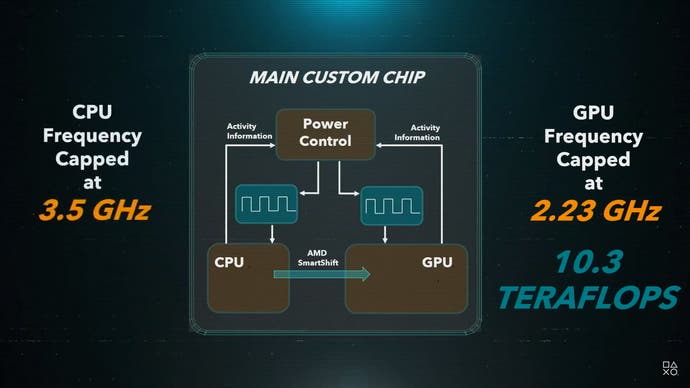
"Rather than look at the actual temperature of the silicon die, we look at the activities that the GPU and CPU are performing and set the frequencies on that basis - which makes everything deterministic and repeatable," Cerny explains in his presentation. "While we're at it, we also use AMD's SmartShift technology and send any unused power from the CPU to the GPU so it can squeeze out a few more pixels."
It's a fascinating idea - and entirely at odds with Microsoft's design decisions for Xbox Series X - and what this likely means is that developers will need to be mindful of potential power consumption spikes that could impact clocks and lower performance. However, for Sony this means that PlayStation 5 can hit GPU frequencies way, way higher than we expected. Those clocks are also significantly higher than anything seen from existing AMD parts in the PC space. It also means that, by extension, more can be extracted performance-wise from the 36 available RDNA 2 compute units.
Not wishing to draw comparisons with any existing hardware past, present or future, Cerny presents an intriguing hypothetical scenario - a 36 CU graphics core running at 1GHz up against a notional 48 CU part running at 750MHz. Both deliver 4.6TF of compute performance, but Cerny says that the gaming experience would not be the same.
"Performance is noticeably different, because 'teraflops' is defined as the computational capability of the vector ALU. That's just one part of the GPU, there are a lot of other units - and those other units all run faster when the GPU frequency is higher. At 33 per cent higher frequency, rasterisation goes 33 per cent faster, processing the command buffer goes that much faster, the L1 and L2 caches have that much higher bandwidth, and so on," Cerny explains in his presentation.
"About the only downside is that system memory is 33 per cent further away in terms of cycles, but the large number of benefits more than counterbalance that. As a friend of mine says, a rising tide lifts all boats," explains Cerny. "Also, it's easier to fully use 36 CUs in parallel than it is to fully use 48 CUs - when triangles are small, it's much harder to fill all those CUs with useful work."
Sony's pitch is essentially this: a smaller GPU can be a more nimble, more agile GPU, the inference being that PS5's graphics core should be able to deliver performance higher than you may expect from a TFLOPs number that doesn't accurately encompass the capabilities of all parts of the GPU. Developers work to the power limits of the SoC, their workloads affecting frequencies on the fly - but it's those factors that impact the clock speeds, not ambient temperatures.
Cerny acknowledges that thermal solutions on prior generation hardware may not have been optimal, but the concept of operating to a set power budget makes the concept of heat dissipation an easier task to handle, despite the impressive clocks coming from the CPU and GPU.
"In some ways, it becomes a simpler problem because there are no more unknowns," Cerny says in his presentation. "There's no need to guess what power consumption the worst case game might have. As for the details of the cooling solution, we're saving them for our teardown - I think you'll be quite happy with what the engineering team came up with."
The PlayStation 5 graphics core
On the face of it, PlayStation 5 delivers a ton of power, but there does seem to be an extra onus on developers to optimise to these new characteristics. The question is, what happens when the processor does hit its power limit and components down-clock? In his presentation, Mark Cerny freely admits that CPU and GPU won't always be running at 3.5GHz and 2.23GHz respectively.
"When that worst case game arrives, it will run at a lower clock speed. But not too much lower, to reduce power by 10 per cent it only takes a couple of percent reduction in frequency, so I'd expect any downclocking to be pretty minor," he explains. "All things considered, the change to a variable frequency approach will show significant gains for PlayStation gamers."
On a features level, Cerny reveals features that suggest parity with other upcoming AMD and AMD-derived products based on the RDNA 2 technology. A new block known as the Geometry Engine offers developers unparalleled control over triangles and other primitives, and easy optimisation for geometry culling. Functionality extends to the creation of 'primitive shaders' which sounds very similar to the mesh shaders found in Nvidia Turing and upcoming RDNA 2 GPUs.
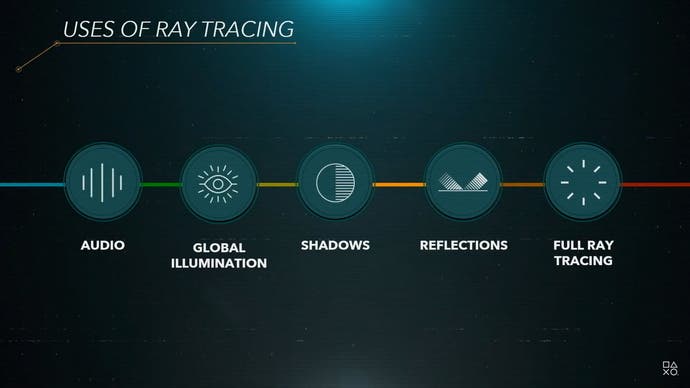
While Cerny doesn't mention technologies such as machine learning support or variable rate shading, PS5 does indeed deliver hardware-accelerated ray tracing via its Intersection Engine, which Cerny says is "based on the same strategy as AMD's upcoming PC GPUs". There had been speculation of an external block, but that's not the case - like next-gen Navi and Xbox Series X, the RT hardware is built into the shaders and so fully integrated. Similar to the RDNA implementation, PS5 will have access to the same kind of RT implementations we've seen in the PC space - reflections, ambient occlusion, shadows and global illumination are a good fit.
"How far can we go? I'm starting to get quite bullish," says Cerny. "I've already seen a PS5 title that is successfully using ray-tracing-based reflections in complex animated scenes, with only modest costs."
How the SSD delivers the next generation dream
The nature of the SoC and its features is important - and so much of it is new information, and crucial information based on feedback from our audience. However, what's clear from the presentation is that Mark Cerny has very different priorities - and there's the small matter of the next-gen dream to consider. Two very specific components are in play here: the SSD and a remarkable piece of 3D audio hardware dubbed the Tempest engine.
Sony is doubling down on solid-state storage in providing a truly transformative next generation experience. Every couple of years, Mark Cerny travels the world, meeting dozens of developers and publishers and the integration of the SSD was the number one next-gen request. Sony's actual implementation is something else, with performance rated at two orders of magnitude faster than PlayStation 4. 2GB of data can be loaded in one quarter of a second, meaning that in theory, the entirety of PS5's 16GB can be filled in just two seconds. "As game creators, we go from trying to distract the player from how long fast travel is taking - like those Spider-Man subway rides - to being so blindingly fast that we might even have to slow that transition down," says Cerny.
Delivering two orders of magnitude improvement in performance required a lot of custom hardware to seamlessly marry the SSD to the main processor. A custom flash marries up to the SSD modules via a 12 channel interface, delivering the required 5.5GB/s of performance with a total of 825GB of storage. This may sound like a strange choice for storage size when considering that consumer SSDs offer 512GB, 1TB or more of capacity, but Sony's solution is proprietary, 825GB is most optimal match for the 12-channel interface and there are other advantages too. In short, Sony had more freedom to adapt its design: "We can look at the available NAND flash parts and construct something with optimal price performance. Someone constructing an M.2 drive presumably does not have that freedom, it would be difficult to market and sell if it were not one of those standard sizes," Mark Cerny says.
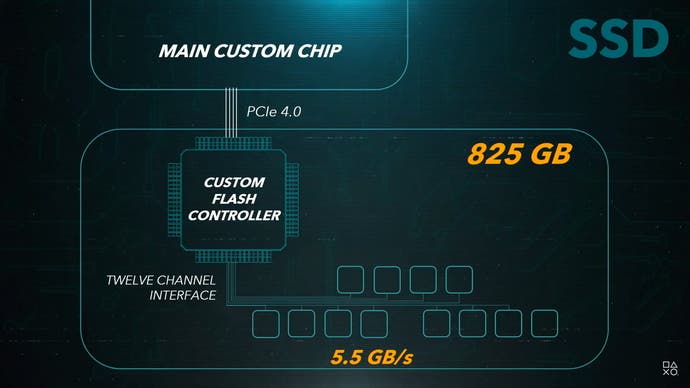
The controller itself hooks up to the main processor via a four-lane PCI Express 4.0 interconnect, and contains a number of bespoke hardware blocks designed to eliminate SSD bottlenecks. The system has six priority levels, meaning that developers can literally prioritise the delivery of data according to the game's needs.
The controller supports hardware decompression for the industry-standard ZLIB, but also the new Kraken format from RAD Game Tools, which offers an additional 10 per cent of compression efficiency. The bottom line? 5.5GBs of bandwidth translates into an effective eight or nine gigabytes per second fed into the system. "By the way, in terms of performance, that custom decompressor equates to nine of our Zen 2 cores, that's what it would take to decompress the Kraken stream with a conventional CPU," Cerny reveals.
A dedicated DMA controller (equivalent to one or two Zen 2 cores in performance terms) directs data to where it needs to be, while two dedicated, custom processors handle I/O and memory mapping. On top of that, coherency engines operate as housekeepers of sorts.
"Coherency comes up in a lot of places, probably the biggest coherency issue is stale data in the GPU caches," explains Cerny in his presentation. "Flushing all the GPU caches whenever the SSD is read is an unattractive option - it could really hurt the GPU performance - so we've implemented a gentler way of doing things, where the coherency engines inform the GPU of the overwritten address ranges and custom scrubbers in several dozen GPU caches do pinpoint evictions of just those address ranges."
All of this is delivered to developers without them needing to do anything. Even the decompression is taken care of by the custom silicon. "You just indicate what data you'd like to read from your original, uncompressed file, and where you'd like to put it, and the whole process of loading it happens invisibly to you and at very high speed," Cerny explains.
How Sony tackles expandable storage
Ever since Mark Cerny first revealed the proprietary nature of the SSD, questions have been asked about expandable storage. What happens when you've filled your allocated 825GB of storage? Well, PlayStation 5 is backwards compatible - and you can save space by running your older games from standard external storage. It won't be as fast as booting from the internal SSD, but it'll free up space for the next-gen titles that are going to need it. Once the limit is hit, we suspect that games can be backed up to standard hard drives, but there is an option to boost SSD storage.
We've seen Microsoft's proprietary drives but Sony is sticking with its strategy of allowing users to buy off-the-shelf parts and fit them into the console themselves - so yes, NVMe PC drives will work in PlayStation 5. The only problem is that PC technology is significantly behind PS5. It'll take some time for the newer, PCIe 4.0-based drives with the bandwidth required to match Sony's spec to hit the market.
And then, Sony needs to validate them to ensure that they will work properly. The PS5 will have an NVMe slot, but drive compatibility will be paramount. It's not just a bandwidth issue either, though clearly that is a factor. PS5's spec delivers six priority levels to developers, while the NVMe spec has just two.
"We can hook up a drive with only two priority levels, definitely, but our custom I/O unit has to arbitrate the extra priorities - rather than the M.2 drive's flash controller - and so the M.2 drive needs a little extra speed to take care of issues arising from the different approach," says Cerny. "That commercial drive also needs to physically fit inside the bay we created in PS5 for M.2 drives. Unlike internal hard drives, there's unfortunately no standard for the height of an M.2 drive, and some M.2 drives have giant heat sinks - in fact, some of them even have their own fans."
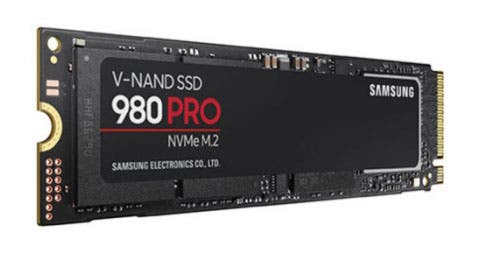
While the internal SSD solution is proprietary, with what might be considered a non-standard capacity, this will have no impact on the storage available from compatible M.2 drives, if you buy a 1TB or 2TB drive, that's the storage you'll have available. "The M.2 drive will have its own flash controller with its own (invisible) internal interface to its NAND flash dies. We don't know, or need to know, the details of that internal interface, or the size and type of NAND flash attached via that interface," Cerny explains. "What's relevant is the M.2 drive's external interface (eg four lanes of Gen4 PCIe so it can hook up to our flash controller) and the read bandwidth it can support via that interface."
In short, expandable storage is possible and you won't need proprietary drives from Sony to get the extra space you want. However, in the short term at least, the advice is simple: don't buy an NVMe drive without Sony validation if you plan to use it in PlayStation 5. Also remember that extreme bandwidth PCIe 4.0 NVMe drives are likely to be very expensive - in the short term, at least. This is cutting-edge technology, after all. Obviously though, the outlook should improve significantly as the next generation progresses - and prices do tend to drop significantly over time.
Unprecedented 3D audio fidelity via the Tempest Engine
Seriously, this is hardcore. In conversation with Mark Cerny, he laments that he gets to meet very few audio engineers on his regular visits to developers and publishers - and that for delivering a next generation audio experience, Sony itself had to take point. Audio itself has been fairly poorly served across the current generation, typically getting a fraction of a Jaguar core to deliver 7.1 surround - far less than audio enjoyed in the PS3 era, where the SPUs proved ideally suited to audio processing tasks. In fact, Cerny points to PSVR as a modern-day standard bearer of sorts for surround audio, as it features a bespoke audio unit capable of supporting "50 pretty decent sound sources". PlayStation 5's new Tempest Engine supports hundreds - delivered with a much higher quality.
It's all based around the key tenets of presence and locality. Cerny describes presence vividly. In games today, rain is a simple, single sound. With the Tempest Engine, PlayStation 5 aims to engender the feeling of actually being in the middle of the shower by simulating the sound of individual raindrops hitting the ground around you. Locality? This is more about being able to precisely track where objects are located - and the science in delivering this is simply astonishing, having to taken into account the shape of your ears and even the size and shape of your head.
To precisely simulate accurate positioning, Sony needs to generate a table called the Head-related Transfer Function - HRTF - ideally on a per-person basis. How you perceive audio can be simulated by processing the soundscape through that table - a computationally expensive task to say the least. The Tempest Engine is effectively a re-engineered AMD GPU compute unit, stripped of its caches and relying solely on DMA transfers - just like a PS3 SPU. In turn, this opens the door to full utilisation of the CU's vector units.
"Where we ended up is a unit with roughly the same SIMD power and bandwidth as all eight Jaguar cores in the PS4 combined," Mark Cerny reveals in his presentation. "If we were to use the same algorithms as PSVR, that's enough for something like five thousand sound sources - but of course we want to use more complex algorithms, and we don't need anything like that number of sounds."
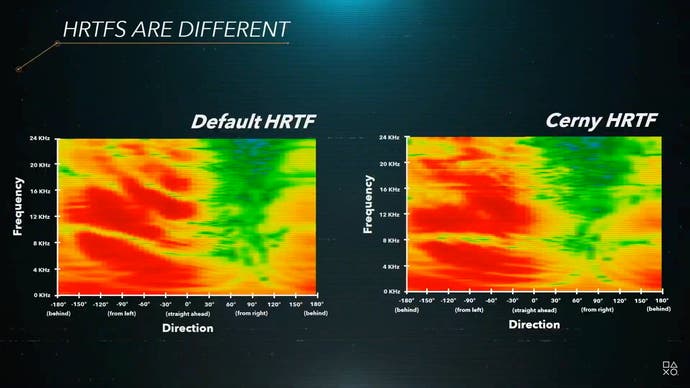
In short, the Tempest Engine opens the door to a genuine revolution in game audio - and while there are challenges ahead in seeing the system reach is fullest potential, one thing you don't need to worry about is buying into high-end audio hardware to enjoy the experience. In the short term, the simple solution will be to use headphones: two ears, two speakers - it's all you need and the Tempest Engine will handle the rest. Going forward, Sony is optimistic about great results from virtual surround from TV speakers and sound bars, with multi-speaker systems also due for support.
However, the ambition of the surround audio system is such that we may not see its potential fully realised for some time. Processing audio via the HRTF system presents challenges in that everyone's head and ears are different. Sony has modelled HRTFs for around a hundred people to get some idea of the variation and come up with five presets for launch. A configuration tool will ensure that the best is selected for you. Obviously though, being able to input your own HRTF will present the ultimate experience - and achieving this is ongoing research.
"Maybe you'll be sending us a photo of your ear, and we'll use a neural network to pick the closest HRTF in our library," suggests Mark Cerny. "Maybe you'll be sending us a video of your ears and your head, and we'll make a 3D model of them and synthesise the HRTF. Maybe you'll play an audio game to tune your HRTF, we'll be subtly changing it as you play, and home in on the HRTF that gives you the highest score, meaning that it matches you the best. This is a journey we'll all be taking together over the next few years. Ultimately, we're committed to enabling everyone to experience that next level of realism."
So that's the key pitch from Sony in this beat of its lead-up to the release of PlayStation 5 and it's exciting stuff. There's a genuine desire here to propel gaming in new directions, while at the same time retaining the ease of development that became a hallmark of the current generation. And if the instant loading strategy pays off, we will have recaptured the immediacy of plug and play console gaming that has diminished rapidly over the last couple of generations. What we've seen today is a blueprint for a design that - as Mark Cerny says - embraces both revolution and evolution.
Obviously though, there is still much that remains under wraps. Unlike the Microsoft reveal earlier this week, Sony is still keeping a lot of its cards close to its chest. The only example of the SSD in action we've seen remains wobbly-cam footage of an early Marvel's Spider-Man demo - while by its very nature, demonstrating the capabilities of the Tempest Engine without going hands-on (or rather, ears-on) is going to be enormously challenging. And then there's the matter of the form factor. Sony's choice to introduce what is effectively variable frequency to its processor with a power limit may hint at a more traditional console design, as opposed to the radical solution opted for by the competition. But right now that's just speculation. We now know much more about the next generation Sony console - but clearly we're still some way off the big reveal.


